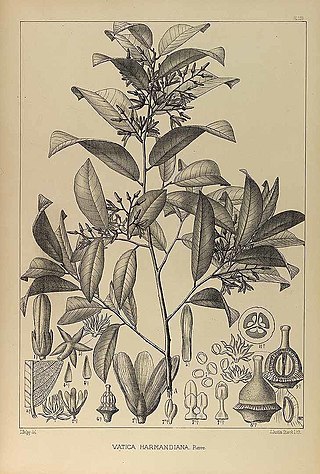Vatica badiifolia is a tree in the family Dipterocarpaceae, native to Borneo. The specific epithet badiifolia means "chestnut brown leaf", referring to the colour of the dry leaf.
Vatica brevipes is a tree in the family Dipterocarpaceae, native to Borneo. The specific epithet brevipes means "short foot", referring to the petiole.

Vatica harmandiana, also known by the synonym Vatica cinerea, is a species of plant in the family Dipterocarpaceae. It is a smallish tree native to Southeast Asia. It is the most common plant species in certain types of mature woodland habitat within its range and is furthermore common in disturbed secondary forests covering much of its range, nonetheless it was considered, along with most Dipterocarpaceae, to be endangered by the IUCN between 1998 and 2017. It is usually not commercially harvested except for local use.
Vatica compressa is a tree in the family Dipterocarpaceae, native to Borneo. The specific epithet compressa means "compressed", referring to the twig when young.
Vatica congesta is a tree in the family Dipterocarpaceae, native to Borneo. The specific epithet congesta means "congested or combined", referring to the inflorescences.
Vatica coriacea is a tree in the family Dipterocarpaceae, native to Borneo. The specific epithet coriacea means "leathery", referring to the leaves.
Vatica globosa is a tree in the family Dipterocarpaceae, native to Borneo. The specific epithet globosa means "spherical", referring to the nuts.
Vatica parvifolia is a tree in the family Dipterocarpaceae, native to Borneo. The specific epithet parvifolia means "small leaf".
Vatica pedicellata is a tree in the family Dipterocarpaceae, native to Borneo. The specific epithet pedicellata refers to the prominent flower stalk or pedicel.

Vatica rassak is a tree in the family Dipterocarpaceae, native to Maritime Southeast Asia. The specific epithet rassak is from resak, the species' Malay common name.
Vatica sarawakensis is a tree in the family Dipterocarpaceae. It is named for Sarawak, part of the species' range in Borneo.
Vatica dulitensis is a tree in the family Dipterocarpaceae, native to Borneo. It is named for Mount Dulit in Sarawak.
Vatica albiramis is a tree in the family Dipterocarpaceae, endemic to Borneo. The specific epithet means 'white twigs'.
Vatica borneensis is a tree in the family Dipterocarpaceae, native to Borneo.
Vatica endertii is a tree in the family Dipterocarpaceae, native to Borneo. It is named for the Dutch botanist F. H. Endert.
Vatica glabrata is a tree in the family Dipterocarpaceae, native to Borneo. The specific epithet means 'smooth-skinned'.
Vatica micrantha is a tree in the family Dipterocarpaceae, native to Borneo. The specific epithet means 'small flowers'.
Vatica oblongifolia is a tree in the family Dipterocarpaceae, native to Borneo. The specific epithet oblongifolia means 'rather long leaf'.
Vatica patentinervia is a tree in the family Dipterocarpaceae, native to Borneo. The specific epithet patentinervia means 'widely divergent nerves', referring to the leaf veins.
Vatica vinosa is a tree in the family Dipterocarpaceae, native to Borneo. The specific epithet vinosa means 'grape-coloured', referring to the hairs covering various parts of the plant.


